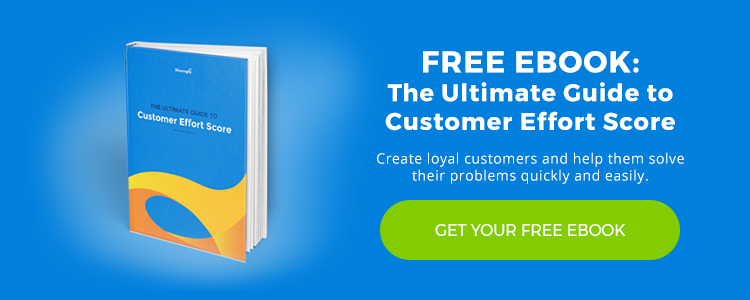“I know it when I see it.”
This famous quote by Justice Potter Stewart of the US Supreme Court, attempted to explain the grey area around obscene movies. Maybe I can’t define it, he said, but I surely know it when I see it.
Customer friction points are the same thing. We can’t completely define customer effort, but we all know when we feel it.
Customer effort is that feeling of banging your head against a brick wall when dealing with customer service. It’s like swimming through mud. Running through sand. It’s when everything should be easy peasy lemon squeezy, but it’s actually difficult difficult lemon difficult.
When we’re customers, we don’t need to define customer effort. We know when we experience friction points, and usually choose to stop what we’re doing.
As support pros, it might not always be obvious when we’re making things difficult for our customers. But we still need to be on the lookout for ways we can make the lives of our customers easier.
Reducing customer effort pays off. 96% of customers who’ve been through a high effort experience report being disloyal (as opposed to only 5% of customers in low effort experiences). In this case, loyalty means purchasing again or recommending your product to a friend. Being disloyal means cancelling their account, spreading poor word-of-mouth or not purchasing again.
Even if you aren’t using the Customer Effort Score survey, reducing friction points will make your customers happier. Here’s six ways you could be making your customer’s lives difficult difficult lemon difficult.
Needing to repeat themselves
Do you find yourself telling the same story to multiple reps when getting help? You’re not alone. 56% percent of customers report having to repeat their issue during a conversation with customer service.
Encourage frontline reps to read through conversation history before beginning to ask questions. If you work in phone support, try a “warm transfer” to provide a low effort experience. A warm transfer is when the first agent introduces the customer and their questions to the new agent before leaving the customer in their hands. A warm transfer might sound something like this:
“Hi Sarah! I’ve got Bill on the line and he’s having some trouble getting his internet connected. We’ve already cycled the power and checked to make sure everything is plugged in properly. Can you take it from here?”
It prevents customers from needing to explain themselves over again. Plus, agents know what’s already been tried and can continue with the troubleshooting.
Inconsistent information or policies
Customers should get the same response from everyone in the company. One support rep thinks something is a bug, the other tells you it’s supposed to work that way. Maybe marketing launched a new promotion and no one knows how it works. Out of date websites, documentation or policies cause frustration and uncertainty. If your company can’t get on the same page, how can you possibly help customers effectively?
Communicating policy changes to a full company can be difficult. Even when you email out new information, some employees will inevitably skip over it.
For important updates, try a threefold approach:
- Communicate it – either through Slack or email
- Pin it – use a #meta Slack channel or a notice board to highlight important changes
- Say it – remind employees of the update face to face during team standups or training sessions.
Extra clicks
Every extra step a customer has to take is creating more friction points. Extra clicks might be clicking through multiple pages to find help information or filling out a super long contact form for a simple question.
Put yourself in your customer’s shoes and try to accomplish a simple task like upgrading your account. How many menus deep is it buried in? Do they have to contact you? How can you reduce the number of steps customers need to take?
Eliminating friction points from clicks is one of the reasons why we make our satisfaction surveys one click. Adding more steps to the survey reduces the number of responses you receive, and it’s just not necessary.
Difficult to find help
While customers do love helping themselves with documentation, some issues can only be resolved by humans. If contact information is difficult to find, customers will be more frustrated when they finally reach help.
Human help can be hidden from customers in a ton of different ways. Maybe there’s a long recording and IVR help menu on your phone system. Perhaps your email address isn’t visible on the help site. Maybe you’re trying out bots on your live chat and they aren’t that helpful.
Once customers decide they need help, make the path to human contact as easy as possible. Dialing a business phone number and immediately hearing a friendly, helpful voice pick up is a beautiful thing.
Too much back and forth
It feels like magic, or mind reading, when an agent resolves your issue with the first reply. First contact resolution is a low effort experience. The opposite situation – multiple back and forth emails or chats that go on for hours are high effort experiences.
Back and forth conversations are usually a sign that the agent isn’t reading the situation properly. Either they’re troubleshooting the wrong problem or they haven’t been clear enough in their responses.
Keep an eye out for conversations that go on and on without a resolution. If you use Nicereply at the bottom of every reply, you’ll start seeing fewer positive ratings on conversations with more replies.
Channel switching
A classic high effort experience, channel switching is when a company changes the method you’re using to communicate mid-problem. A “channel” is a communication method your customers use to get in touch with you, like email, snail mail, chat, or social. You might have emailed in with a question, only to be told you’ll need to call the helpline instead. Maybe you’ve sent a tweet and the company directed you to a contact form.
Not only does channel switching result in the need to repeat information, it also feels like jumping through hoops just to talk to a company you’re paying money to.
One time I called a concert ticket provider to transfer tickets to a friend – only to be told I had to *fax* a form to them. The ultimate channel switch, just to accomplish an easy task.
If you can, resolve customer inquiries on the same channel they contact you on. Not only is it easier for the customer – it’s also more efficient for your front line team!
The Hunt for Customer Effort
Your customers know effort when they see it. The easiest way to learn where you’re making customers work hard is to ask them!
Learn how to create and send your first Customer Effort Score survey now.
Focussing on the above six drivers of customer effort can definitely make a difference to your customers. But using the Customer Effort Score to hear what your customers think will give you super powered effort finding skills. You’ll be able to connect low scores with the friction points and experiences driving them.










